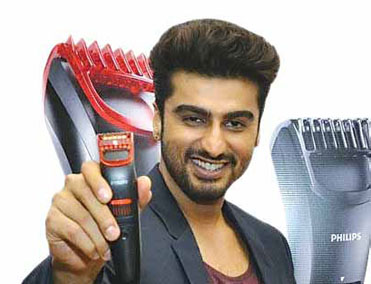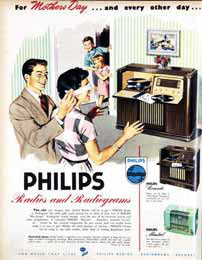
Their vision is to put the customer first. From healthcare to consumer lifestyle and lighting, the company’s outstanding brand resonance is proof of the power of simplicity. A closer look at its history
Let’s make things better Sense and simplicity Innovation and You
Like the tag lines employed by the ads for Philips products indicate, this is one company that has succeeded in carving an indelible niche in the minds of its customers, with the simple but effective strategy of demystifying technology--and putting the customer at the centre of each experience. Uncluttered, comfortable and straightforward, the Philips ads are effective, modern and to the point. Usually with a young and happening brand ambassador (like Ranbir Kapoor and Alia Bhatt in recent years) demonstrating how its products _ be they modular switches, hair straighteners or electronic hair removers - have made their lives easier and better. No fuss, no muss. Research shows that while everyone wants cutting edge technology to be part of their lives, no one wants to go read long winded journals. But as the ads prove - it does not have to be that way. Not if it’s Philips.
As per reports, Philips India chief marketing officer Vivek Sharma said the company, along with its agency Ogilvy & Mather, had undertaken extensive research with consumers in order to help understand their needs and culture. “That’s how we arrived at the latest brand positioning: Innovation and You."
Not that the previous slogans were less effective, but they were true to the demands of the era.
“In keeping with today’s needs, the company would go all out to tap the potential of social media like Facebook and Twitter in order to better understand their needs,” Sharma said.
The other markets it did similar research included the US, China, Europe and Brazil. India is currently the sixth largest market for Philips.
But then, Philips wears its awesome history with ease - and ensures its products keep pace with cultural and lifestyle requirements.
If that’s not technology wed to tradition, what is?

The Philips story dates back to 1891, Eindhoven (the Netherlands) where it was set up by Gerard Philips and his father Frederick who helped finance the purchase and set up of a simple and empty factory building. The company started with making electro-technical products, especially carbon filament lamps. (This first factory is now a museum - a must visit for all industrial history buffs). The initial years were rather difficult, but the arrival of Anton, Gerard’s younger brother changed everything. He was an engineer who combined his technical knowledge with an understanding of sales, and soon the business began to gain ground. The Philips Metal Filament Lamp Factory Ltd was set up in 1908, followed in 1912 by the foundation of Philips Light bulb Factories Ltd. Soon both brothers changed their family business by founding the Philips Corporation, thereby laying the foundation for the later electronics multinational. Right through the 20s and 30s the company continued to add newer and newer products to its range: from vacuum tubes to electric razors and their iconic radios, Philips made inroads into the lives of the common people.
Even as several corporates have made their fortune off war crimes (or dealings that cannot withstand closer scrutiny), this is one company that stood apart thanks to the efforts of Frits Philips, Anton’s son - the only member of the family to remain behind in the Netherlands, post German invasion of the country in World War II. Heavily dependent on technology to sustain the war effort, the Nazis let the factory function - on their terms, of course. They had no problems with Frits, as long as he toed their line. But the brave and humane Frits saved the lives of almost 400 Jews by convincing the evil Nazi regime that they were absolutely necessary for the production at Philips. He did this at considerable risk to himself - and was honoured for his war time contribution later.
It was in 1930 that Philips started operations in India at Calcutta (now Kolkata). The company comprised a staff of 75 and was a sales outlet for Philips lamps imported from Europe. As per the company ideology of promoting the industrial development of emerging economies, Philips India set up its first Indian lamp-manufacturing factory in 1938 in Calcutta (Kolkata). Subsequently, Philips decided to produce radio receivers in India to make this product readily available. In 1948, Philips started manufacturing radios in Kolkata. In keeping with the establishment of Doordarshan and All India Radio, independent India’s first mass-media - to say nothing of a relatively more relaxed postwar, post-independence generation, the first valve-based Philips set was well received by the consumers. This was a major turning point for Philips India, and marked the beginning of the company’s subsequent growth in the world of electronics. In 1957, the company was converted into a public limited company, and the restas they say, is history. As per statistics, company has around 9,500 employees in India, of which 4,500 are in manufacturing and 3,000 in research and development while some 2,000- odd are part of the commercial division. Philips India reported a turnover of around Rs.6,000 crore last fiscal with the lighting and healthcare divisions each contributing around 50 percent to the revenue.
It has four manufacturing (Mohali, Baroda, Chennai and Pune) facilities and four R&D units (Bangalore, Noida, Pune and Chennai) in the country. Philips in last two years has invested more than $15 million, or about Rs.95 crore, in its Noida R&D centre that helped it launch more than 150 LED light products.
The Philips story dates back to 1891, Eindhoven (the Netherlands) where it was set up by Gerard Philips and his father Frederick who helped finance the purchase and set up of a simple and empty factory building

As per the company’s annual reports, all three key sectors of the company lighting, healthcare and consumer lifestyle posted robust top line growth and a definite increase in their respective market shares. The lighting sector of the company grew by 7.2 percent (Rs.34,488 crore) for the financial year ended March 31, 2015, over the corresponding period of the previous financial year, mainly driven by strong growth in professional lighting solutions. Meanwhile, the healthcare sector of the company, grew at 9.3 percent (Rs.12.922 crore). The company maintained its market share, despite continued pressure on costs, fluctuating currency and high interest costs, the reports said. Besides, the company strengthened its market leadership position in India in cardiology and MRI, while maintaining its leadership position in patient monitoring and non-invasive ventilators for respiratory care.
Even the Consumer Lifestyle Sector continued to gain modestly (Rs.9,247 crore as opposed to Rs.8, 577 crores in 2013-14), and strengthened its market share by introduction of categories such as Air purifier, high end steam irons and Kerashine range of hair products. In the domestic appliances business, Air fryer, a new product introduced last year, continued to perform well. Apart from all this, the company continued to build share in the personal care business in India, led by male grooming and beauty products.
'Love is in your milk. Express it with the Comfort Electric Breast Pump’ (for Philips breast pumps)
Or Fry, break, grill without oil (Philips air fryer) or even ‘An experience beyond the ordinary’ (for the Philips’ unique Ambilight that makes your screen seem much wider)
Each ad weds emotion to reason - and explains why the product is for you. It also helps that Fast Company recognised Philips on its influential ‘50 Most Innovative Companies for 2014 list, as well as naming Philips in the top 10, of the Energy and Internet of Things subcategories. “To win in such a fast-changing environment requires a new kind of business agility,” explains Fast Company editor Robert Safian. The listing was based on not only traditional markers but also “progressive, sustainable business models and an ethos of creativity”.
While other industrial giants, both Indian and MNC continue to up the ante - with strong products and visible advertising, Philips is in a league of its own, perceived to be equipped with old roots, wed to new wings - and an enthusiastic R & D department.
By Kalyani Sardesai